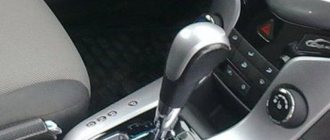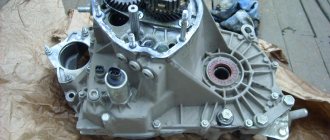The Niva 21214 car is distinguished by its increased cross-country ability on roads. The car has an engine that has a volume of 1.7 liters, which complies with Euro-4 standards. The transmission system includes a transfer case with a crankcase ventilation system. All components on the VAZ 21214, just like on the VAZ 21213, are characterized by a long service life. It is important to take proper care of the automotive system and select high-quality oil for the Niva.
The Niva SUV (VAZ 2121), which has all-wheel drive and is equipped with a manual transmission, is capable of producing 75 horsepower.
Complete oil change for VAZ 21213 in all units
The service life of the vehicle directly depends on timely maintenance. Changing the oil is one of the operations that is performed in accordance with the regulations specified in the vehicle maintenance instructions. Changing the oil and consumables on a VAZ 21213 is easy to do yourself, following the step-by-step instructions. But this makes it possible to save time and money on visiting a service station.
According to the regulations, the oil on the VAZ 21213 must be changed every 10 thousand kilometers or every 2 years of operation. In addition, it is necessary to periodically check the condition of the lubricant. If the car is used in difficult conditions, the replacement period is halved to 5 thousand kilometers.
The frequency of replacement is influenced by the following factors:
- quality of fuels and lubricants;
- driver's driving style:
- terms of Use;
- technical condition of the vehicle.
It is recommended to fill in the same brand of oil that was filled previously. When changing the brand of lubricant or when purchasing a used car, you need to flush the engine system with a special flushing agent or new lubricant before replacing it. To flush, the old oil is drained and flushing or new lubricant is added. Next, start the engine and let it run for about 10 minutes. Next, drain the waste and begin the usual procedure for changing the oil.
The oil filter is changed along with the lubricant if it has run out of service life, which is the same as that of the oil - 10 thousand km. When replacing the lubricant ahead of schedule, the oil filter can be left, but experts recommend changing it at each replacement.
To carry out the procedure, you should prepare:
- new consumables: lubricant and filter;
- five-liter bottle for draining waste liquid;
- watering can;
- hexagon to “12” or wrench to “17”;
- screwdriver;
- oil filter puller;
- clean rags;
- gloves.
When buying motor oil, you need to pay attention to the viscosity. The manufacturer of VAZ 21213 recommends using a product with a viscosity of 5w-30 or 5w-40.
The replacement must be done on a warm engine. It is advisable to change the lubricant immediately after a trip. If the car has been parked, you will need to start the engine and let it run until it warms up to operating temperature. The heated lubricant drains better.
It is more convenient to carry out work on an overpass, inspection pit or other lifting device to provide access to the bottom of the machine. The car's wheels must be secured to prevent rolling back. To do this, use the handbrake. Additionally, you can place boards or shoes under the wheels.
The replacement process consists of a sequence of steps:
- Having unscrewed the mounting bolts, first remove the engine protection, if any.
- Next you need to unscrew the plug on the drain hole. Depending on its type, we do this with a hexagon or a “17” key.
- We place the prepared container under the drain hole in advance. You can use a five-liter plastic bottle.
- We wait until all the waste liquid is drained. This takes no more than 15 minutes. Be careful when draining as the oil is very hot and can cause burns. You should work with gloves.
- The next step is flushing the system, if necessary.
- After draining the lubricant and flushing the system, we proceed to replacing the oil filter. We place a container under the place where the filter is located, since residual lubricant may leak out of it.
- We unscrew the oil filter manually or using a special wrench.
If you cannot unscrew it manually and there is no puller, you can use a screwdriver or any long sharp tool. We pierce the filter housing and, using a screwdriver as a lever, unscrew it.
- Next, we clean the seat of the product from dirt so that it does not get into the engine with new lubricant.
- On a new product, be sure to apply fresh engine oil to the seal. We fill the new consumable halfway with lubricating fluid so that it gets into the system faster and the engine elements do not rotate without lubrication.
- Screw the prepared filter onto the fitting by hand ¾ of a turn until the O-ring comes into contact with the cylinder block gasket.
- Next, unscrew the plug from the oil filler neck.
- We control the volume of the poured substance using a probe. It is considered sufficient if the oil on the dipstick is between the minimum and maximum levels.
- After filling in about 4 liters of lubricant, start the engine and wait for the oil indicator on the dashboard to go out. The lubricant should fill the entire system. We turn off the engine and measure the oil level again. If there is not enough lubricant, add more.
Throughout the entire operation of the vehicle, it is necessary to constantly monitor the level and condition of the engine oil. Top up and change as needed.
Changing gearbox fluid
The gearbox is the most reliable part of the car; it rarely fails. To keep it in working condition, you need to fill it with high-quality liquid and change it according to the regulations. The transmission fluid on the VAZ 21213 is replaced after 60 thousand km, checking the level every 20 thousand km. It is considered normal if the liquid in the crankcase reaches the edge of the oil filler neck. If necessary, add liquid.
Replacement is carried out in a pit or other device that provides access to the bottom of the car. To implement it on a VAZ 21213, you need to have on hand:
- hexagon to “12”;
- key to "17";
- a canister or container for draining the waste substance;
- special syringe;
- clean rags;
- new transmission fluid.
Before starting the procedure, you should warm up the gearbox. To do this, it is enough to drive 10 kilometers.
The replacement process takes place in stages:
- Going under the car, use a hexagon to unscrew the plug from the drain hole.
- Drain all the liquid into the prepared container.
- When the lubricant has completely flowed out, clean the plug from dirt and screw it back into place.
- We unscrew the plug on the filler neck with a key to “17”.
- We use a syringe to fill in new oil.
- Pour in the liquid and control its level. Normal - grease reaches the lower edge of the neck.
- Screw the plug back.
This completes the replacement procedure.
Changing the lubricant in the rear axle
The oil in the unit is changed in the same way as in the gearbox, every 60 thousand km, and the level is checked after 20 thousand km. The required level is the edge of the hole through which the oil is poured.
For replacement, we are preparing a set of keys, a 5-liter container, and clean rags.
Replacement sequence:
- We set the car on a hill, having previously warmed up the bridge, driving 10 km.
- Taking a hexagon, unscrew the plug from the drain neck and let the oil flow into an empty container.
- Wipe the unscrewed plug with a clean rag and return it to its place.
- Using a key set to “17”, unscrew the plug on the hole through which we will fill the lubricant.
- Using a syringe, pour in the prepared oil until it is flush with the edge of the filler hole.
- Using a key set to “13”, unscrew the breather. Clean it and screw it back in.
Should it be changed or not?
Of course, there is not such a critical need for changing the oil (the structure is different), but in my opinion it is still necessary to change it. And that's why:
- The gears are made accurately from the factory, I don’t argue, especially if it’s some serious brand, say SKODA or TOYOTA. BUT whatever one may say, during operation, after a certain long period of time, metal shavings will still form and float in the oil. But the manual transmission has no filters!
- The lubricant itself loses its properties after a certain service life; of course, the mileage can be enormous, for example 150 or 200,000 kilometers, but it will darken, become saturated with chips or even carbon deposits (say, if it has been skidding for a long time).
- If noise or hum appears when the manual transmission is operating, this indicates a lot of wear on the gears. And it appears for a reason, it is the spent chips that slowly but surely grinds down the surfaces of the teeth.
After changing the oil, after a long mileage, you notice that the shifts have become smoother, the gears are better lubricated with new oil, which means the work will be smoother.
What else I want to note, guys in manual transmission, changing the oil is cheap. It itself is inexpensive, and there’s simply not enough of it, just a couple of liters! Not like in an automatic transmission, often about 8 - 10 liters.
Personally, I would do this, change it every 60 - 70,000 km (believe me, it’s really cheap), then at 150,000 there would be no “hum” at all! Of course, those who will now say that the oil in a manual transmission lasts its entire service life are right in some ways, you can drive like that, it won’t be a mistake! But the new lubricant, I repeat once again, protects and makes the “box” work - IN A NEW WAY, softly, pleasantly, 100%, and the protection is restored again, the chips go away.
Now let's watch a short video.
I’ll finish here, read our AUTOBLOG.
How to change oil in VAZ Niva axles - AvtoMaslo
28.06.2019
» Articles » 21214 Niva oil change in transfer case
For any vehicle, the importance of timely replacement of lubricants cannot be overestimated. Oils used in components and assemblies subject to friction at high speeds significantly reduce their overheating and wear, helping to extend their service life.
Among such components, one cannot fail to note the transfer case, which is equipped with all-wheel drive vehicles.
Both old Niva cars and models under the Chevrolet brand, produced since 2002, need no introduction - these are one of the most popular all-wheel drive vehicles in our country, which have earned the love of motorists for their unpretentiousness, ease of maintenance and low cost.
What is especially pleasing is that the vast majority of maintenance operations on a domestic SUV can be performed independently, without turning to the help of specialists or a car service center. In particular, this also applies to changing the oil in the Niva transfer case - a procedure that does not require special professional skills or special tools.
The oil in the Niva transfer case should be checked every 10 thousand km.
Replacement frequency
According to the recommendations given in the service book, the oil in the transfer case of a Niva car should be changed for the first time during the fourth maintenance, that is, after driving 45 thousand kilometers. Then the procedure should be repeated with the same frequency.
It should be especially noted that on the new Niva the transmission oil is changed after running-in (2000 km). It is recommended to check the lubricant level in the transfer case every 10 thousand kilometers.
However, experts advise focusing not so much on the recommended indicators, but on the condition of this important unit, as well as factors related to the operating conditions of the vehicle.
It’s one thing when the car drives mainly on good roads (urban, on country roads), and quite another when its owner lives in the countryside or is an avid hunter, fisherman, or simply a big fan of outdoor activities.
In such cases, checking the level and quality of the oil in the transfer case should be carried out more often, and if signs of fluid contamination appear, it should be replaced without waiting for the regulatory deadlines.
So you decide for yourself when to change the oil in the Niva transfer case, taking into account all the above factors.
Checking the oil level
The procedure for checking the oil level in the Niva transfer case is quite simple, in any case, it does not require any special skills.
The only difficult point is that it is necessary to provide access to the bottom of the car, for which you will need to drive it into a hole, overpass, or securely install it on blocks.
The second point is that the check must be carried out on a cold car, so if you have driven somewhere before, wait until the car has cooled down.
The procedure itself is simple - just unscrew the filler plug with a 12mm hexagon, having first thoroughly cleaned the seat of dirt, and use a suitable object (a wooden stick or a piece of wire) to measure how much lower the liquid level is at the bottom edge of the hole. If this distance exceeds 10 mm, topping up should be done, which is done using a special syringe. You need to add until the lubricant begins to flow out of the hole, then wipe the box dry and tighten the plug.
Choosing the right oil
The issue of choosing a lubricant for the Niva transfer case and axles should be taken responsibly, because the reliable operation of these transmission elements ensures that you will never find yourself in a situation requiring outside help.
Recommended transmission fluids have characteristics that ensure optimal operation of the vehicle component for which they are intended. If you know exactly what kind of oil is poured into the transfer case, the choice is simplified: just purchase a lubricant with the same viscosity.
If this information is not available, it’s also not a problem: you just need to drain all the old transmission fluid, that is, do not limit yourself to topping up if, say, the level is too low and the lubricant itself is not yet very contaminated.
The automaker fills the transfer case with mineral water, but when replacing the fluid, the preferred lubricant would be semi-synthetic, which has better performance characteristics that are more suitable for the climate of our country.
How much to fill
According to the data given in the operating manual, the volume of oil poured into the transfer case of the Niva-2121 and more modern modifications (21213, 21214, 21310) is 0.75 liters. Some reference books give a figure of 0.79 liters, which is not important - you still need to purchase liquid packaged in a 1-liter container.
The procedure for changing the oil in a Niva transfer case yourself
If, as a result of another check of the level or quality of the transmission fluid in the transfer case, it turns out that it is time to replace it (symptoms indicating the need to perform such a procedure may be not only a very dark color of the oil with the inclusion of solid particles, but also the appearance of noise when turning on the transfer case or during its operation), you can perform such a replacement on your own.
To do this, you will need a 19 and 12 hex wrench, a liter container for used lubricant and some rags. It will also be necessary to provide access to the car from the bottom, for which you can use a lift, an overpass or an inspection hole.
Immediately before replacement, you should warm up the car (drive it for about 10 kilometers). Procedure for changing the oil in the Niva transfer case:
- We place a prepared container under the drain hole (preferably with a wide neck to avoid spilling liquid);
- Using a 19mm hex key, unscrew the drain plug, being careful not to get dirty or burn yourself;
- thoroughly clean the plug itself and the magnets installed on it from all dirt and metal shavings;
- when the transmission fluid stops dripping, install the plug in its original place, ensuring sufficient, but not excessive tightening force;
- Using a 12mm hex, unscrew the filler plug, using a special technical syringe or funnel with a suitable neck, fill in fresh lubricant until its level reaches the lower edge of the technological hole;
- tighten the plug;
- carefully clean the seat of the filler neck with a rag to remove any oil leaks;
- We repeat the same procedure with respect to the breather located at the transfer case on the side of the propeller shaft (rear).
Reasons for withdrawal
Everyone knows that the gearbox on cars is the most unpretentious product, but only if you handle it correctly. Let's start from the beginning: the Chevrolet Niva is an all-wheel drive SUV, which, from the very design, was prepared for a track with various types of obstacles. Overcoming obstacles means loading the car, and loads and overloads of the vehicle cause many problems, in particular, parts of the engine, gearbox, clutch, etc. fail.
Thus, the reasons for dismantling the gearbox may be as follows:
- Removal for subsequent replacement of the entire mechanism. But it’s immediately worth noting that a new box is installed only if the old one is completely unusable. But this doesn’t happen often, only on cars with high mileage.
- For carrying out repair and cleaning work. This work may include: replacement of failed components, gaskets, scenes and other products. It all depends on what was disabled.
- When carrying out repair work on other vehicle components, if the gearbox interferes with these activities.
We won’t take a long look at what you already know, but let’s get straight to the process of dismantling the gearbox on a Chevrolet Niva.
To carry out work on removing the gearbox, in addition to free time, you will also need the necessary tools.
Tool for the job
In order to remove the gearbox from a Niva Chevrolet, you must use the following tool:
- A set of wrenches, in particular, a wrench for “10”, “12”, “13”, “17”.
- A set of hexagons, in particular with a diameter of 12 mm.
- A container for draining used oil from the box.
- Pliers and a set of screwdrivers.
- For ease of implementation, we recommend that removal be carried out by two people, since the gearbox unit is quite heavy.
After making sure that these tools are available, you can install the Niva Chevrolet SUV on the inspection hole and proceed directly to the process of removing the gearbox.
Removing the gearbox: everything in order
Before starting the procedure for removing the transmission from a Niva Chevrolet SUV, be sure to set the car to the handbrake and place shoes under the wheels. Also open the hood and remove the negative terminal from the battery. This is necessary to avoid unintentional short circuiting.
So, let's start removing:
- Having descended into the inspection hole, find the plug on the gearbox for draining the used oil. Before unscrewing it, prepare a special container. The container must have a capacity of at least 1.7 liters.
- Using a hexagon, the plug is unscrewed and the oil is drained. The drain takes about 10 minutes. While the oil is draining, it is not allowed to carry out any work on the box.
After removing the box from the Niva Chevrolet, you can begin carrying out repair work, replacing worn mechanisms, or installing a new gearbox.
After carrying out repair work, make sure that the device is assembled correctly and does not need to be removed again. It is recommended to invite a specialist to carry out repair work on the gearbox if you are not confident in your capabilities. The gearbox is installed in the reverse order of removal. Finally, do not forget to pour oil into the box and check its sufficient level.
At this stage, the process of removing the gearbox from a Niva Chevrolet car can be considered complete.
Changing the oil in the VAZ 2121 gearbox
How often do you change the gearbox oil? — According to the car’s service book, the gearbox oil needs to be changed every 40 thousand km. If the car is new, then the first replacement must be made after 2 thousand km, and the next replacement after 40 thousand km.
How much oil should be poured into the gearbox? — 1.6 l.
What kind of oil should I put in the gearbox? — Gear oil with API GL-5 and viscosity 75W-90 Use the table to determine the oil of the appropriate viscosity. See recommended oil brands here .
Recommended temperature ranges for use of transmission oils.
Is it necessary to flush the gearbox when changing the oil? — If the oil is excessively contaminated or has foreign impurities, the gearbox can be washed by pouring 1 liter into it. flushing oil. — Close the filler plug, set the transfer case lever to the neutral position, engage 1st gear in the gearbox and run the engine for 2-3 minutes; — drain the flushing oil completely;
— wipe the oil drain plug and put it in place.
https://www.youtube.com/watch?v=EykBwTvzr6A
We carry out the work on an inspection ditch or a lift. Before changing the oil, you need to warm it up by driving the car for at least 10 km. and immediately begin replacing before it cools down.
Use a 12mm hex to unscrew the drain plug...
...and drain the oil into a substitute container. (prepare a container with a volume of at least 2 liters)
Cleaning the drain plug magnet...
Using a 17 key, unscrew the filler plug. We perform flushing (if necessary) as described at the beginning.
Using a syringe, fill in new oil to the level of the lower edge of the filler hole (in the photo the front driveshaft has been removed for clarity).
The oil level should reach the edge of the filler hole, or millimeters below.
We wrap the filler plug.
Owners of domestic VAZ 2121 and 2131 cars should know what gear oil to fill and how to do it correctly with their own hands in a garage? This requires a suitable lubricant and a certain set of tools, and we will talk about this in detail in today's material.
The physical and mechanical properties of various Niva gearbox oils affect their performance properties. Not every car owner understands the intricacies, and determines the oil only by the range of use of a particular product. Experts recommend following a number of criteria when choosing gear oil for Niva:
- the oil must be suitable taking into account the current condition of the gearbox;
- the product must meet the requirements of the car manufacturer;
- suitable for the season of operation of the car;
- gear oil for VAZ 21214 or 21213 must be real.
Another important rule should be mentioned: never choose oil based on the principle that the more expensive the better. Often it turns out to be completely wrong.
Manufacturer's requirements
The car manufacturer, taking into account the design features of a particular transmission, puts forward requirements that the oil used by car owners must satisfy. These requirements are always indicated in the service book. On the packaging of any oil, in addition to the product name, there is always a marking with the following information:
- viscosity grade;
- operational group.
The gearboxes of VAZ 2121 all-wheel drive vehicles have a hypoid main pair, which operates at high speeds at low torques and shock loads on the gears. Oils for these domestic machines must belong to the following operational groups:
- according to foreign API classification: GL-5;
- according to national standards - 5th group.
After studying the service book for the car, you will find the automaker's recommendations for a specific group. Using lower groups of oils in hypoid axles will lead to unpleasant consequences. For example, scuffs may form on the rubbing elements, and this will cause expensive major repairs or replacement of the entire gearbox. First of all, this is due to the fact that oils of low performance groups have lower welding load and scuffing index, that is, they cannot withstand the necessary loads.
Another important indicator that is present in the marking of gear oils is the viscosity class. All oils, including transmission oils, are divided into all-season and seasonal.
Read about changing engine oil in Niva on our website at the following link.
Seasonal oils
They are classified as Newtonian fluids, in which the viscosity depends on the operating temperature. When it increases, the viscosity decreases in direct proportion, and when it decreases, the viscosity increases. Seasonal oils are not subject to temporary drops in viscosity due to the absence of expensive thickening fillers in order to reduce the cost of the product.
Source: https://AVSU-pitanie.ru/info/zamena-masla-v-kpp-vaz-2121/
Classification of transmission oils
Transmission oil is a lubricating fluid for gearboxes, created from petroleum products or synthesized chemicals with the addition of special functional additives (anti-scuff, anti-corrosion and anti-wear), which protects parts from wear and overheating.
The operating principle of transmission fluid is based on the creation of a special film that protects parts by covering them and protects them from harmful factors of complex operating parameters.
Classification of oils by base and viscosity:
- mineral;
- semi-synthetic;
- synthetic.
To operate a car with a manual transmission in the summer or in climatic conditions with positive temperatures most of the time (there are either no negative temperatures, or occasionally drop just below zero), you can use mineral oil.
In winter (when the thermometer drops below -10) or when there are significant temperature changes (from very low to very high), it is necessary to use synthetic or semi-synthetic gear oil.
A universal and inexpensive option is a semi-synthetic liquid.
Mineralka
Mineral oil (85W-90) is the cheapest option for transmission fluid, created from refined petroleum products with the addition of sulfur-based additives.
This oil creates a dense and durable film on parts, regardless of operating conditions; in cars with significant mileage, it seals collapsing oil seals and gaskets, protecting them from leakage.
Mineral transmission fluid has lower fluidity, higher density and thickens at low temperatures, which leads to increased gasoline consumption and increased wear of the box before the fluid warms up in the manual transmission.
Has a tendency to oxidize and requires more frequent replacement due to reduced performance.
Mainly used in cars older than 10-15 years. It is an environmentally friendly product, which affects the price, making it attractive and affordable.
Semi-synthetics
Semi-synthetic gear oil (80W-90) is based on petroleum products with the addition of additives and is the “golden mean” between cheap mineral and expensive synthetic, including the ideal combination of quality and price.
The characteristics of this oil are close to those of synthetics at a more affordable price.
Synthetics
Synthetic transmission fluids (75W-80, 75W-90) are produced by synthesizing chemicals; they have greater fluidity and are less dependent on the ambient temperature range, which makes them all-season.
This product has excellent protective and cleaning characteristics, enhanced by additional additives.
In addition to its high cost, the disadvantages of this type of oil include the likelihood of leakage through oil seals and gaskets in manual transmissions with significant mileage. Synthetic fluid changes over a longer mileage than semi-synthetics, and even more so mineral water.
Synthetics are the most acceptable option for moderate climates, allowing you to operate a car with a manual transmission all year round without the risk of increased wear or seasonal replacement of the fluid in the box. Ideal for new cars.
Changing the oil in the Niva 21214 gearbox
For any vehicle, the importance of timely replacement of lubricants cannot be overestimated. Oils used in components and assemblies subject to friction at high speeds significantly reduce their overheating and wear, helping to extend their service life. Among such components, one cannot fail to note the transfer case, which is equipped with all-wheel drive vehicles.
Malfunctions
Problems with the gearbox can be identified by several signs. The most common ones are:
- transmission noise
- Difficulty shifting gears
- spontaneous shutdown
- oil leaks on the body
Also on restyled models, a knock appears in the transmission after 5-10 thousand kilometers.
In this case, it is necessary to pay attention to the conditions under which the knocking appears.
In rare cases, the link fails. This is the unit that is responsible for the interaction between the transmission and the rod. There are 3 main signs that the malfunction is associated with this particular unit:
- Large lever play
- Problems when selecting gear
- Inability to adjust the mechanism
All problems arising with the transmission require immediate elimination, since this directly affects not only the serviceability of the vehicle but also traffic safety.
Choice.
The oil in the Niva Chevrolet box must have certain parameters. They show the freezing level and viscosity of the oil.
In this case, W stands for winter or winter type, which is used at subzero temperatures. SAE is an international classification of oils, according to which every car owner can select the type of product according to specific conditions of use.
In this article we will talk about how to change the oil in the gearbox, transfer case and axles of a Chevrolet Niva. The use of high-quality lubricants for vehicles plays an important role in the operation of any car. The most common process for proper vehicle operation is the oil change process . It is possible to change the oil yourself, without resorting to the help of auto service employees, while significantly saving money.
Lubrication
On previous versions, drivers encountered problems with the lever's operation. It was possible to accidentally engage reverse gear instead of fifth. This issue has now been fixed. The solution was found in the form of installing a blocker, which is located at the end of the traction fork.
Now, to engage reverse gear, you need to squeeze the clutch and only then move the lever to position R. In this case, the locking stop drops below the special lining. In order for the mechanism to work properly inside, when the speed is turned on, constant lubrication occurs due to the splashing of oil. Therefore, to prevent oil leakage from the transfer case and dirt and dust not to get inside, the landing spots of the primary and secondary shafts are sealed with oil seals.











